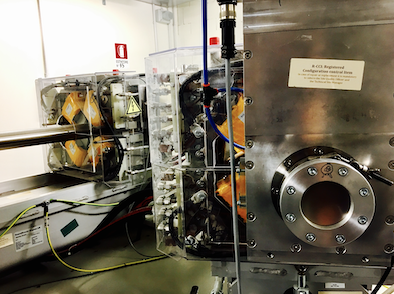Speaker
Description
In the last years, our group has performed different radiation physics experiments from the fields of particle therapy and space radiation protection. This contribution will summarize briefly the conducted experiments and present the obtained results.
One experiment investigated the entrance channel of proton Bragg curves. The shape of the first few centimetres of a proton depth dose profile is determined by the interplay of two different build-up effects: the build-up of delta electrons in the first few millimetres and the build-up of secondary protons and target fragments in the first few centimetres. Both could be characterized with high precision during an experiment at the Trento proton therapy center with a 220 MeV beam. A setup consisting of two large area parallel plate ionization chambers and polyethylene targets was used to measure the dose build-up and a permanent magnet was used to separate the two effects from each other [1].
In another experiment in Trento, we investigated a new alignment procedure for CMOS sensors. These first tests have proven the feasibility of the new software concept [2].
Also a scintillation detector setup that was later used in experiments at the Marburg Ion Therapy Center (MIT) to measure PET isotope production cross sections [3] was first tested at the experimental beamline in Trento.
Within the ROSSINI-2 project aiming on the characterization of shielding materials for cosmic radiation, we performed an experiment in Trento where the production of secondary neutrons in different shielding materials and their dose behind the shielding targets was assessed using TLD detectors at different angles [4].
[1] T. Pfuhl, F. Horst, C. Schuy, U. Weber Dose build-up effects induced by delta electrons and target fragments in proton Bragg curves - measurements and simulations. PMB 63 (2018).
[2] C. -A. Reidel, C. Finck, C. Schuy, M. Rovituso, U. Weber. Alignment procedure of silicon pixel detectors for ion-beam therapy applications. NIMA 931 (2019).
[3] F. Horst, W. Adi, G. Aricò, K.-T. Brinkmann, M. Durante, C.-A. Reidel, M. Rovituso, U. Weber, H.-G. Zaunick, K. Zink, C. Schuy Measurement of PET isotope production cross sections for protons and carbon ions on carbon and oxygen targets for applications in particle therapy range verification. PMB 64 (2019).
[4] C. Schuy, C. La Tessa, F. Horst, M. Rovituso, M. Durante, M. Giraudo, L. Bocchini, M. Baricco, A. Castellero, G. Fioreh, U. Weber Experimental Assessment of Lithium Hydride's Space Radiation Shielding Performance and Monte Carlo Benchmarking. Radiation Research 191 (2018).

